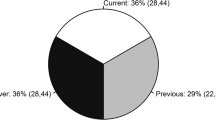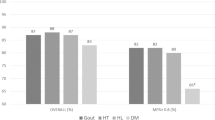Abstract
Gout is the most common form of inflammatory arthritis in men, yet both patients and the public often do not recognise gout as a form of arthritis. Instead, due to historical misconceptions, gout is typically seen as a lifestyle disease caused by poor diet. In reality, there are a number of risk factors that contribute to gout, including genetic factors. Views of gout as precipitated by lifestyle alone can lead to stigma, and maladaptive beliefs that it should be treated primarily through dietary changes. This is thought to contribute to poor uptake of, and adherence to, effective pharmaceutical treatments. Gout has some of the poorest medication adherence rates of any chronic disease, contributing to suboptimal health outcomes for patients. Recent research suggests that when gout is referred to as ‘urate crystal arthritis’ (a rarely used name for gout), the perception of the disease by members of the public was more accurate. It was viewed as being less under personal control (i.e. less appropriately managed by behaviours such as dietary intake), and more appropriately managed by long-term medical treatment. This finding raises the possibility that patients themselves might also benefit from gout being explicitly labelled as arthritis. Indeed, parallels can be drawn between this case and other diseases that have recently had their names changed to improve outcomes, namely primary biliary cirrhosis and schizophrenia. A movement away from the term gout may benefit those living with the disease by changing illness perceptions and increasing uptake of, and adherence to, guideline-recommended treatment(s).
Similar content being viewed by others
References
Kuo C-F, Grainge MJ, Zhang W, Doherty M. Global epidemiology of gout: prevalence, incidence and risk factors. Nat Rev Rheumatol. 2015;11(11):649.
Dirken-Heukensfeldt KJ, Teunissen T, Van de Lisdonk E, Lagro-Janssen A. Clinical features of women with gout arthritis. A systematic review. Clin Rheumatol. 2010;29(6):575–82.
Khanna PP, Nuki G, Bardin T, Tausche A-K, Forsythe A, Goren A, et al. Tophi and frequent gout flares are associated with impairments to quality of life, productivity, and increased healthcare resource use: results from a cross-sectional survey. Health Qual Life Outcomes. 2012;10(1):117.
Dalbeth N, Haskard DO. Inflammation and tissue damage in crystal deposition diseases. Curr Opin Rheumatol. 2005;17(3):314–8.
Dalbeth N, Petrie KJ, House M, Chong J, Leung W, Chegudi R, et al. Illness perceptions in patients with gout and the relationship with progression of musculoskeletal disability. Arthritis Care Res. 2011;63(11):1605–12.
Becker MA, Schumacher HR, MacDONALD PA, Lloyd E, Lademacher C. Clinical efficacy and safety of successful longterm urate lowering with febuxostat or allopurinol in subjects with gout. J Rheumatol. 2009;36(6):1273–82.
Kuo C-F, Grainge MJ, Mallen C, Zhang W, Doherty M. Rising burden of gout in the UK but continuing suboptimal management: a nationwide population study. Ann Rheum Dis. 2015;74(4):661–7.
Briesacher BA, Andrade SE, Fouayzi H, Chan KA. Comparison of drug adherence rates among patients with seven different medical conditions. Pharmacotherapy. 2008;28(4):437–43.
Scheepers LE, van Onna M, Stehouwer CD, Singh JA, Arts IC, Boonen A, editors. Medication adherence among patients with gout: a systematic review and meta-analysis. In: Seminars in arthritis and rheumatism; 2018.
Nuki G, Simkin PA. A concise history of gout and hyperuricemia and their treatment. Arthritis Res Ther. 2006;8(S1):S1.
Doherty M, Jansen TL, Nuki G, Pascual E, Perez-Ruiz F, Punzi L, et al. Gout: why is this curable disease so seldom cured? Ann Rheum Dis. 2012;71(11):1765–70.
Major TJ, Dalbeth N, Stahl EA, Merriman TR. An update on the genetics of hyperuricaemia and gout. Nat Rev Rheumatol. 2018;14(6):341–53.
Spencer K, Carr A, Doherty M. Patient and provider barriers to effective management of gout in general practice: a qualitative study. Ann Rheum Dis. 2012;71(9):1490–5.
Lindsay K, Gow P, Vanderpyl J, Logo P, Dalbeth N. The experience and impact of living with gout: a study of men with chronic gout using a qualitative grounded theory approach. J Clin Rheumatol. 2011;17(1):1–6.
Kleinstäuber M, Wolf L, Jones AS, Dalbeth N, Petrie KJ. Internalized and anticipated stigmatization in patients with gout. ACR Open Rheumatol. 2020;2(1):11–7.
Chandratre P, Mallen CD, Roddy E, Liddle J, Richardson J. “You want to get on with the rest of your life”: a qualitative study of health-related quality of life in gout. Clin Rheumatol. 2016;35(5):1197–205.
Liddle J, Roddy E, Mallen CD, Hider SL, Prinjha S, Ziebland S, et al. Mapping patients’ experiences from initial symptoms to gout diagnosis: a qualitative exploration. BMJ Open. 2015;5(9):e008323.
Fam AG. Gout, diet, and the insulin resistance syndrome. J Rheumatol. 2002;29(7):1350–5.
Vlasnik JJ, Aliotta SL, DeLor B. Medication adherence: factors influencing compliance with prescribed medication plans. Case Manager. 2005;16(2):47–51.
Punzi L, Medea G. Understanding and perceptions of gout: an interdisciplinary assessment among patients, physicians and pharmacists in Italy. Reumatismo. 2020;72(1):31–43.
Vaccher S, Kannangara DR, Baysari MT, Reath J, Zwar N, Williams KM, et al. Barriers to care in gout: from prescriber to patient. J Rheumatol. 2016;43(1):144–9.
Pandya BJ, Riedel AA, Swindle JP, Becker LK, Hariri A, Dabbous O, Krishnan E. Relationship between physician specialty and allopurinol prescribing patterns: a study of patients with gout in managed care settings. Curr Med Res Opin. 2011;27(4):737–44.
Singh JA, Hodges JS, Toscano JP, Asch SM. Quality of care for gout in the US needs improvement. Arthritis Care Res. 2007;57(5):822–9.
Doherty M, Jenkins W, Richardson H, Sarmanova A, Abhishek A, Ashton D, et al. Efficacy and cost-effectiveness of nurse-led care involving education and engagement of patients and a treat-to-target urate-lowering strategy versus usual care for gout: a randomised controlled trial. The Lancet. 2018;392(10156):1403–12.
Goldfien R, Pressman A, Jacobson A, Ng M, Avins A. A pharmacist-staffed, virtual gout management clinic for achieving target serum uric acid levels: a randomized clinical trial. Permanente J. 2016;20(3):15–234.
Spilberg I, Mandell B, Mehta J, Simchowitz L, Rosenberg D. Mechanism of action of colchicine in acute urate crystal-induced arthritis. J Clin Investig. 1979;64(3):775–80.
Petrie KJ, MacKrill K, Derksen C, Dalbeth N. An illness by any other name: the effect of renaming gout on illness and treatment perceptions. Health Psychol. 2018;37(1):37.
Beuers U, Gershwin ME, Gish RG, Invernizzi P, Jones DE, Lindor K, et al. Changing nomenclature for PBC: from ‘cirrhosis’ to ‘cholangitis’. Hepatology. 2015;62(5):1620–2.
Trivedi PJ, Hirschfield GM. Primary biliary cirrhosis: renaming primary biliary cirrhosis—clarity or confusion? Nat Rev Gastroenterol Hepatol. 2015;12(12):678–9.
Lasalvia A, Penta E, Sartorius N, Henderson S. Should the label” schizophrenia” be abandoned? Schizophrenia Res. 2015;162(1–3):276–84.
Sartorius N, Chiu H, Heok KE, Lee M-S, Ouyang W-C, Sato M, et al. Name change for schizophrenia. Schizophrenia Bull. 2014;40(2):255.
Sato M. Renaming schizophrenia: a Japanese perspective. World Psychiatry. 2006;5(1):53.
Koike S, Yamaguchi S, Ojio Y, Shimada T, Watanabe K-I, Ando S. Long-term effect of a name change for schizophrenia on reducing stigma. Soc Psychiatry Psychiatr Epidemiol. 2015;50(10):1519–26.
Funding
Richard O Day’s research was supported by National Health and Medical Research Council (NH&MRC) Program Grant number APP 1054146; Kate Faasse is supported by an Australian Research Council Discovery Early Career Research Award (DE180100471).
Author information
Authors and Affiliations
Corresponding author
Ethics declarations
Conflict of interest
No conflicts of interest.
Additional information
Publisher's Note
Springer Nature remains neutral with regard to jurisdictional claims in published maps and institutional affiliations.
Rights and permissions
About this article
Cite this article
Coleshill, M.J., Aung, E., Carland, J.E. et al. Rebranding Gout: Could a Name Change for Gout Improve Adherence to Urate-Lowering Therapy?. Ther Innov Regul Sci 55, 138–141 (2021). https://doi.org/10.1007/s43441-020-00198-0
Received:
Accepted:
Published:
Issue Date:
DOI: https://doi.org/10.1007/s43441-020-00198-0




